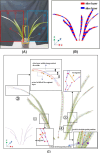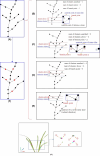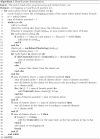An automated phenotyping method for Chinese Cymbidium seedlings based on 3D point cloud
- PMID: 39343899
- PMCID: PMC11441005
- DOI: 10.1186/s13007-024-01277-1
An automated phenotyping method for Chinese Cymbidium seedlings based on 3D point cloud
Abstract
Aiming at the problems of low efficiency and high cost in determining the phenotypic parameters of Cymbidium seedlings by artificial approaches, this study proposed a fully automated measurement scheme for some phenotypic parameters based on point cloud. The key point or difficulty is to design a segmentation method for individual tillers according to the morphology-specific structure. After determining the branch points, two rounds of segmentation schemes were designed. The non-overlapping part of each tiller and the overlapping parts of each ramet are separated in the first round based on the edge point cloud-based segmentation, while in the second round, the overlapping part was sliced along the horizontal direction according to the weight ratio of the tillers above, to obtain the complete point cloud of all tillers. The core superiority of the algorithm is that the segmentation fits the tiller growth direction well, and the extracted skeleton points of tillers are close to the actual growth direction, significantly improving the prediction accuracy of the subsequent phenotypic parameters. Five phenotypic parameters, plant height, leaf number, leaf length, leaf width and leaf area, were automatically calculated. Through experiments, the accuracy of the five parameters reached 98.6%, 100%, 92.2%, 89.1%, and 82.3%, respectively, which reach the needs of various phenotypic applications.
Keywords: 3D point cloud data; Chinese Cymbidium; Phenotyping; Segmentation.
© 2024. The Author(s).
Conflict of interest statement
The authors declare no competing interests.
Figures


















Similar articles
-
A fast phenotype approach of 3D point clouds of Pinus massoniana seedlings.Front Plant Sci. 2023 Jun 26;14:1146490. doi: 10.3389/fpls.2023.1146490. eCollection 2023. Front Plant Sci. 2023. PMID: 37434607 Free PMC article.
-
Dynamic quantification of canopy structure to characterize early plant vigour in wheat genotypes.J Exp Bot. 2016 Aug;67(15):4523-34. doi: 10.1093/jxb/erw227. Epub 2016 Jun 15. J Exp Bot. 2016. PMID: 27312669 Free PMC article.
-
An Accurate Skeleton Extraction Approach From 3D Point Clouds of Maize Plants.Front Plant Sci. 2019 Mar 7;10:248. doi: 10.3389/fpls.2019.00248. eCollection 2019. Front Plant Sci. 2019. PMID: 30899271 Free PMC article.
-
Plant stem and leaf segmentation and phenotypic parameter extraction using neural radiance fields and lightweight point cloud segmentation networks.Front Plant Sci. 2025 Mar 27;16:1491170. doi: 10.3389/fpls.2025.1491170. eCollection 2025. Front Plant Sci. 2025. PMID: 40212877 Free PMC article.
-
Measuring crops in 3D: using geometry for plant phenotyping.Plant Methods. 2019 Sep 3;15:103. doi: 10.1186/s13007-019-0490-0. eCollection 2019. Plant Methods. 2019. PMID: 31497064 Free PMC article. Review.
Cited by
-
Remote sensing-based maize growth process parameters revel the maize yield: a comparison of field- and regional-scale.BMC Plant Biol. 2025 Feb 6;25(1):154. doi: 10.1186/s12870-025-06146-0. BMC Plant Biol. 2025. PMID: 39910424 Free PMC article.
-
Geometrically aware transformer for point cloud analysis.Sci Rep. 2025 May 13;15(1):16545. doi: 10.1038/s41598-025-00789-7. Sci Rep. 2025. PMID: 40360608 Free PMC article.
-
PlantCareNet: an advanced system to recognize plant diseases with dual-mode recommendations for prevention.Plant Methods. 2025 Apr 23;21(1):52. doi: 10.1186/s13007-025-01366-9. Plant Methods. 2025. PMID: 40264213 Free PMC article.
-
LMFE: A Novel Method for Predicting Plant LncRNA Based on Multi-Feature Fusion and Ensemble Learning.Genes (Basel). 2025 Mar 31;16(4):424. doi: 10.3390/genes16040424. Genes (Basel). 2025. PMID: 40282384 Free PMC article.
-
Enhanced Maize Leaf Disease Detection and Classification Using an Integrated CNN-ViT Model.Food Sci Nutr. 2025 Jun 30;13(7):e70513. doi: 10.1002/fsn3.70513. eCollection 2025 Jul. Food Sci Nutr. 2025. PMID: 40599357 Free PMC article.
References
-
- Yasrab R, et al. Predicting plant growth from time-series data using deep learning. Remote Sens. 2021;13:331.
LinkOut - more resources
Full Text Sources

